Recitation 3 Documentation–Blog 5
This week we are asked to build a circuit that contains one of the different sensors that the professor provides. From moisture sensor, infrared sensor, vibration sensor, etc. we choose force sensitive resistor (FSR). And we decide to monitor the electricity current that is floating in the circuit by the speaking function in Arduino first, then we want to make the sensor work by vibrating to make the LED glow. Because the contact is not very good, we have been trying to monitor the current data and replace the sensor in the first half of the class. After changing four sensors we are able to monitor the current data accurately and we then switch to our next goal–control the brightness of the LED. But we failed to make the circuit work at first in that we confuse force sensitive resistor and vibration sensor these two sensors, so we enter the wrong code in Arduino. After we ask help from learning assistants we change to the correct ones and successfully control the light of the LED. At the moment, there is still a small problem happened: When I vibrated the sensor forcefully, the brightness of the LED did not change significantly. After I checked the Arduino code, I found that the vibration amplitude we originally set was too large, so that the change was very small, so I changed 500 After adjusting to 30, we can clearly observe the changes of the LED lights.
Since the time goes out, we didn’t have time to use the map function to change the number of settings, but after I read the instructions I also figured out how to use it.


Code:
Q1: As described above, we choose force sensitive resistor. Since it can work by just being given a force and it is easy to make different and various outcomes, I think this kind of resistor is widely used in the music area and automobile field. For the music field, it can be used in making electronic instruments such as electronic drums and flutes. These instruments requires the force of beating and blowing, and the sensor can effectively monitor the different level of force and then make different sounds for players to play the music. The reason for using this kind of resistor might be that it can monitor the force more accurately and can can produce sounds with very subtle differences.
Q2: I believe that recipe is just one aspect of the tutorials, because it helps people to make delicious dishes under the instructions written on the recipe. Tutorial, as its name suggests, is a period of instruction given by a university or college tutor to an individual or very small group. So the similarity of these two objects is that they can give instructions to their audience and help them understand what they should do. I think the idea can also be applied to code. The use of code allows the circuit that we build to function the way that they are required to. In other words, give the instruction to the circuit and the current that runs in it so that they can be applied into different uses.
Q3: Needless to say, computers are giving lots of assistance to human life , in other words, are having positive impact on human behavior. According to The Language of New Media, the use of computer allows media to be formed from “smaller independent parts, and so on, down to the level of the smallest “atoms”—pixels, 3-D points, or text characters”(30). As a result, computers allow World Wide Web to exist, making it easier for people to get information quickly and from various sources. And this helps human to gather the intelligence or information from others that they aren’t supposed to get. However, sometimes the computers will be too intelligent that they will make guesses about human needs and thoughts, and use the programs they already have to simplify the thinking process for people. As described by Manovich, “The numerical coding of media (principle 1) and the modular structure of a media object (principle 2) allow for the automation of many operations involved in media creation, manipulation, and access. Thus human intentionality can be removed from the creative process, at least in part”(31). The problem brought by this “automation” includes two parts: one is that what humans think will not be fully transport to their designs and their work; the other one will be that human might think fewer and fewer since they believe computers will do that for them.
